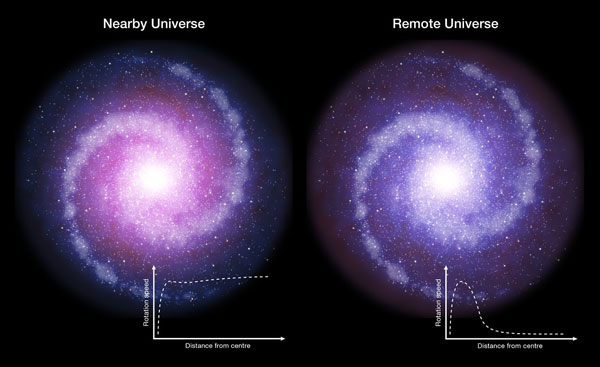Less Dark Matter in Young Galaxies?
-
 by
Budgieye
moderator
by
Budgieye
moderator
The rotation of a galaxy is one of the "trick questions" to confuse beginners. Galaxies are not like a solar system, with Mercury going fast, and Pluto going slow. In our local Universe, all stars in a galaxy move at the same speed. So now we have a "trick trick question".
Nature: http://www.nature.com/nature/journal/v543/n7645/full/nature21685.html
Strongly baryon-dominated disk galaxies at the peak of galaxy formation ten billion years ago
R. Genzel, N. M. Förster Schreiber, H. Übler, P. Lang, T. Naab, R. Bender, L. J. Tacconi, E. Wisnioski, S. Wuyts, T. Alexander, A. Beifiori, S. Belli, G. Brammer, A. Burkert, C. M. Carollo, J. Chan, R. Davies, M. Fossati, A. Galametz, S. Genel, O. Gerhard, D. Lutz, J. T. Mendel, I. Momcheva, E. J. Nelson et al.
AffiliationsContributionsCorresponding authors
Nature 543, 397–401 (16 March 2017) doi:10.1038/nature21685
Received 13 November 2016 Accepted 31 January 2017 Published online 15 March 2017
Article tools
Citation
Reprints
Rights & permissions
Article metrics
In the cold dark matter cosmology, the baryonic components of galaxies—stars and gas—are thought to be mixed with and embedded in non-baryonic and non-relativistic dark matter, which dominates the total mass of the galaxy and its dark-matter halo1. In the local (low-redshift) Universe, the mass of dark matter within a galactic disk increases with disk radius, becoming appreciable and then dominant in the outer, baryonic regions of the disks of star-forming galaxies. This results in rotation velocities of the visible matter within the disk that are constant or increasing with disk radius—a hallmark of the dark-matter model2. Comparisons between the dynamical mass, inferred from these velocities in rotational equilibrium, and the sum of the stellar and cold-gas mass at the peak epoch of galaxy formation ten billion years ago, inferred from ancillary data, suggest high baryon fractions in the inner, star-forming regions of the disks3, 4, 5, 6. Although this implied baryon fraction may be larger than in the local Universe, the systematic uncertainties (owing to the chosen stellar initial-mass function and the calibration of gas masses) render such comparisons inconclusive in terms of the mass of dark matter7. Here we report rotation curves (showing rotation velocity as a function of disk radius) for the outer disks of six massive star-forming galaxies, and find that the rotation velocities are not constant, but decrease with radius. We propose that this trend arises because of a combination of two main factors: first, a large fraction of the massive high-redshift galaxy population was strongly baryon-dominated, with dark matter playing a smaller part than in the local Universe; and second, the large velocity dispersion in high-redshift disks introduces a substantial pressure term that leads to a decrease in rotation velocity with increasing radius. The effect of both factors appears to increase with redshift. Qualitatively, the observations suggest that baryons in the early (high-redshift) Universe efficiently condensed at the centres of dark-matter haloes when gas fractions were high and dark matter was less concentrated.
http://www.skyandtelescope.com/astronomy-news/less-dark-matter-young-galaxies/?utm_source=newsletter&utm_campaign=sky-mya-nl-170317&utm_content=929734_EDT_SKY_170317&utm_medium=email A science editor's explanation

http://www.skyandtelescope.com/wp-content/uploads/dark-matter-rotation-curve-600px.jpg
This artist's impression compares rotating disk galaxies in the distant universe (right) and the present day (left).
ESO
So, did the the dark matter continue to form, or did it come together in one place?
Posted